Trail Blazers Get Away With One
The Blazers blew an 18-point fourth-quarter lead to the Kings but escaped with a win.
Reflecting on the first season of the rebuild.

The Trail Blazers’ 2023-24 season came to an end on Sunday afternoon with a 121-82 loss in Sacramento. Here are 21 final thoughts on the year—one for each of the 21 wins the Blazers had in the first season of their post-Damian Lillard rebuild.
After spending the last several years covering a team whose entire national attention was focused on when and if Lillard was going to ask out, I actually found it kind of refreshing to cover a team that was completely off the radar nationally. After the trade, everyone knew they were going to be bad, and they were, so people outside of Portland left them alone.
For those of you who did watch—and I assume if you’re reading this, you probably did—well, this is what a rebuild looks like. There hasn’t been a true rebuild in Portland in almost two decades. The last time they had a record this bad was 2005-06; that year, they landed Brandon Roy and LaMarcus Aldridge in the draft. After that, until this year, they entered every season with the goal of making the playoffs, whether they did or not. This year, everyone knew the deal: they were going to be bad and you were going to watch these games hoping to see growth and development. It sounds fun on paper, but as I and others tried to warn people in Portland for years who were advocating for trading Lillard to blow it up, it’s not a very enjoyable day-to-day existence. Maybe in a couple of years, they’ll be where Oklahoma City is now (although that kind of quick turnaround is extremely rare), but the 60-point losses, plural, are the price of admission for the hope that they’ll be good in the future. I enjoyed this ESPN story that ran this week about one of the few teams worse than the Blazers, the Washington Wizards. It captures the soul-sucking everyday reality of playing for, or running, a team whose goal is to lose every day. The Blazers have more talent than the Wizards do, but it’s a similar dynamic.
And by the way, next year is going to be very much the same, at least from a results standpoint. Between now and June, you’re going to hear a lot about how this year’s draft class, where the Blazers could have two lottery picks if Golden State loses in the play-in, is one of the worst classes of the 21st century. But next year’s class? I spent some of this past week at the Nike Hoop Summit game and practices in Portland, where most of the NBA’s front offices congregated to watch some of the top high-school players in the world. And the scouts and executives I talked to said that there are at least five kids from the 2025 draft class that would easily go No. 1 if they were in this draft. If you thought the end-of-season tanking around the league for Victor Wembanyama last year was bad, it’s going to be similar next year and the Blazers are very much going to be a part of it. So be prepared.
I really, really like Scoot Henderson. Going into the year, his development was seen as the most important thing to keep an eye on—how could it not be, considering how high he was drafted and who he was replacing at point guard? On the court, it was rocky. Some very promising games and stretches of games, some pretty rough low points. About what you’d expect—teenage point guards learning how to play in the NBA are rarely ever good right away. But getting to know him over the course of his rookie season is what makes me think he’s going to be just fine. I heard great things about him before he got here from people who had spent time around him, and after a year with him I can say that all of it is true. He’s a really impressive kid. All the intangible stuff you want to hear about a young player is there—he’s a worker, a good teammate, wants to be great, listens to coaching, etc. Everyone loves him. His energy is always positive and he doesn’t carry himself like he’s above anyone or anything, the way some guys do coming in as high lottery picks with as much hype as he had. I don’t know exactly how good he’s going to be—franchise point guard, All-Star, just a good starter—but I’m pretty confident he’s going to beat the “bust” allegations that cropped up during some of the down periods of his first season.
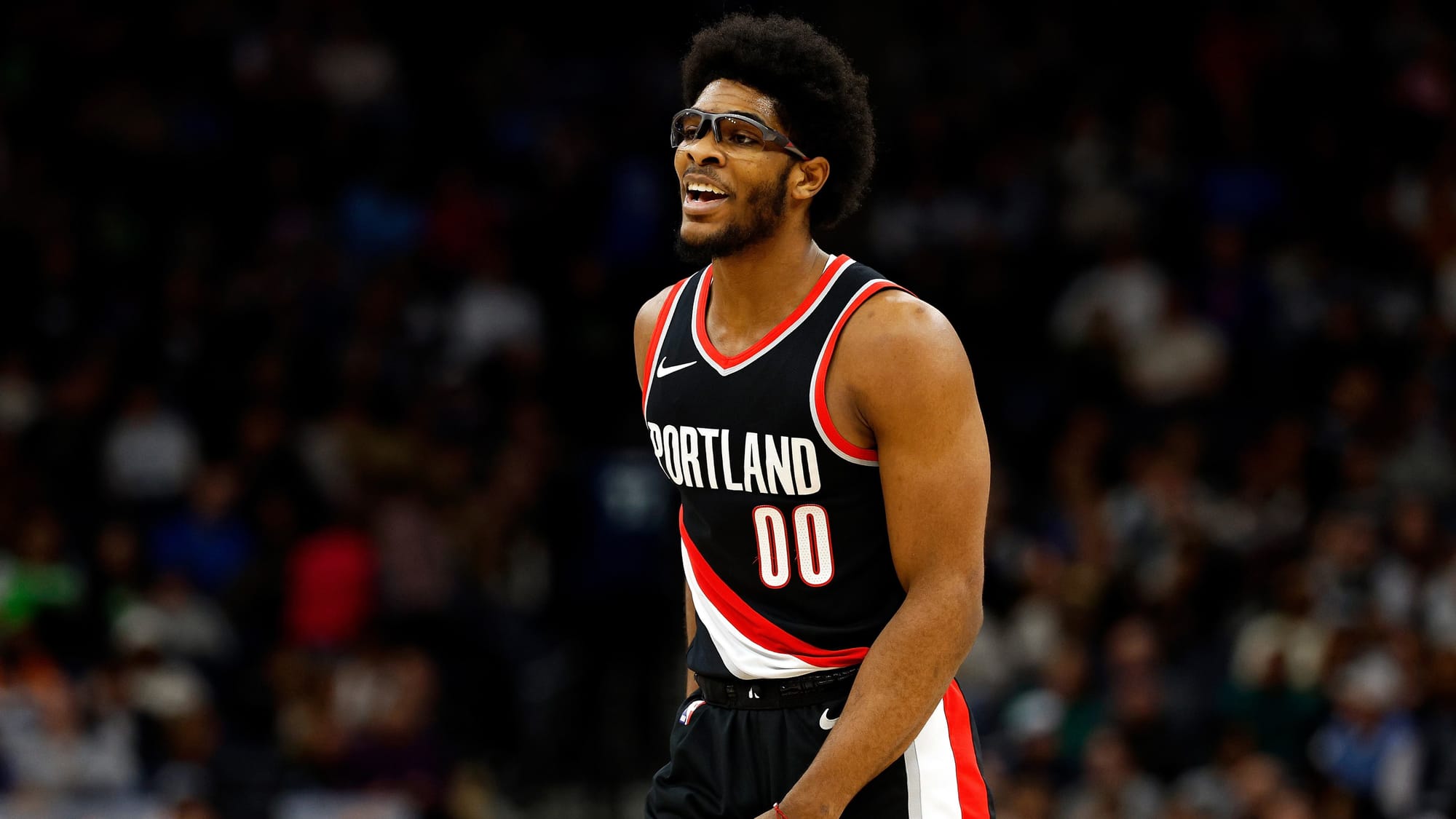
My favorite part of this job has always been the relationships and getting to know people, and this was a really good locker room. It’s actually a little shocking how good it was. You don’t usually see that with teams this bad—guys check out and form cliques and start chasing their own stats or their next contracts. But I was in there as much as anyone not employed by the team, and I can honestly say that from the start of training camp to now, there wasn’t any drama, guys not getting along, guys being resentful of other guys playing ahead of them, any of that. The veterans came into the season knowing what the deal was, and the young guys did their work and waited their turn.
Deandre Ayton, the biggest name the Blazers got back in the Lillard trade, had an interesting first season in Portland. The best way to explain it is that he confirmed everybody’s pre-existing opinions about him, whatever they were. If you came into the season thinking Ayton was a disappointing former No. 1 pick who put up empty numbers and whose engagement and effort came and went, you probably came out of this year still thinking that. But if you were someone who thought he was unfairly blamed for how things ended in Phoenix and believed the hyper-athletic two-way center who anchored a Suns team that went to the Finals in 2021 is still in there, you saw enough—particularly in the second half of the season—to also feel vindicated. At least for right now, the Blazers are comfortable with him as their starting center going forward and feel that overall, the positive outweighs the negative. It’s a similar dynamic to the one they had for years with Jusuf Nurkic in that spot. Both are flawed players but they’re both good enough that it’s not exactly easy to go out and get someone better at that position. Ayton’s always going to be an easy social-media target because he’s done things like give himself the nickname “DominAyton” and miss a game because he’s trapped in an ice storm. But he’s also a good guy who lightens the mood in the locker room. I think he’s been mischaracterized nationally but I also get why that’s happened.
Barring a sudden change of plans in the next 24 hours, expect Chauncey Billups to be back as the head coach next season—the final guaranteed year on his contract.
With that said, there are going to have to be some big roster changes this summer because of simple math. We’ll get more into this in the coming days and weeks, but Joe Cronin needs to figure some things out on a few fronts in the next several months.
Pour one out for Blazers legends Ish Wainright, Jamaree Bouyea, Skylar Mays and Taze Moore.
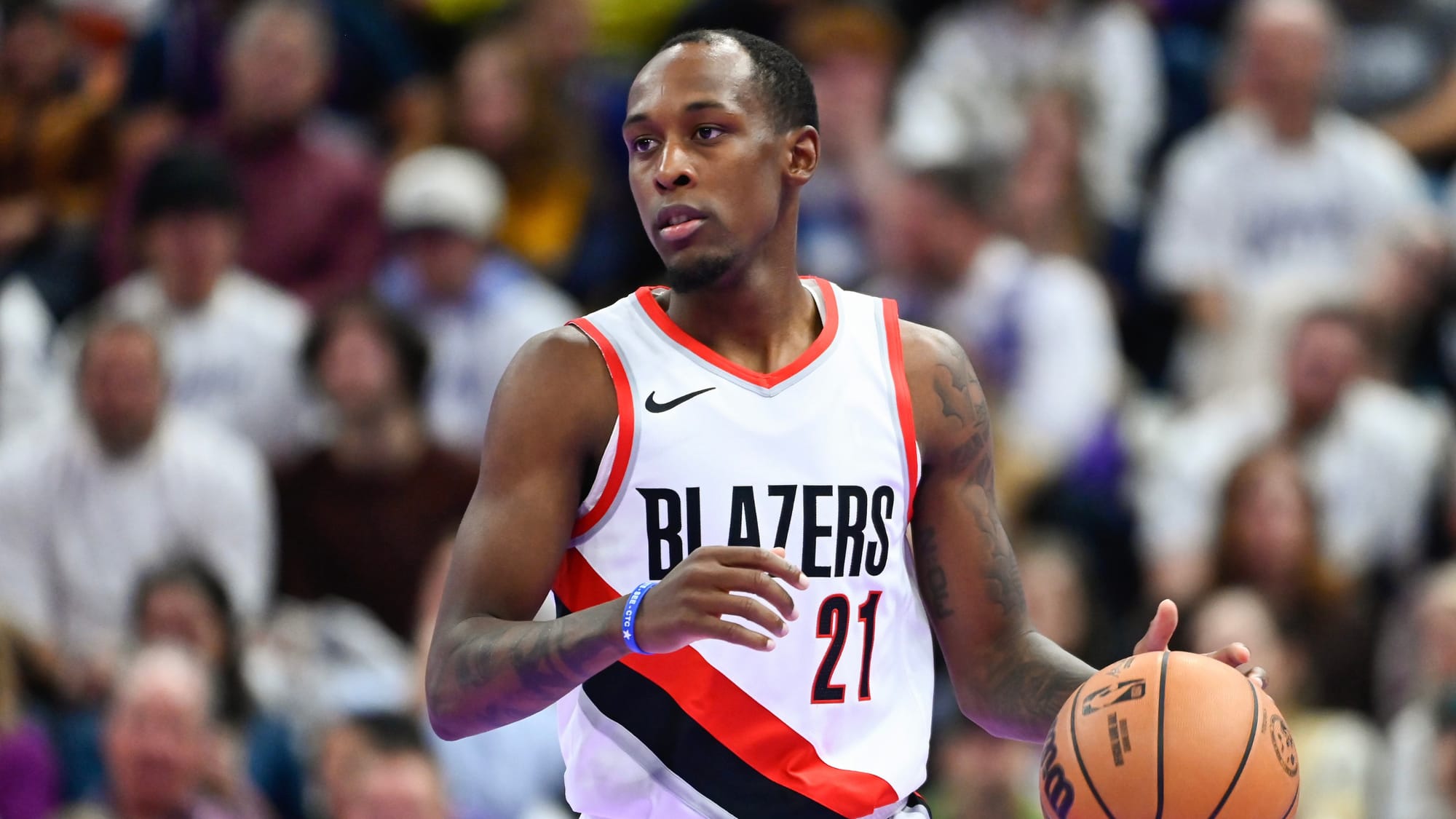
It’s hard not to feel like this was a lost season to some degree, just because the Blazers’ five most important players going forward—Henderson, Ayton, Anfernee Simons, Shaedon Sharpe and Jerami Grant—were all healthy at the same time for a total of four games. The injuries piled up from the beginning of the season: Simons tore his thumb in the first half of the season opener and missed six weeks; Henderson had an ankle injury a week into the season that cost him nine games; Robert Williams III suffered a season-ending knee injury after playing just six games; just as Henderson and Simons came back in early December, Sharpe started dealing with the core muscle injury that eventually required surgery and Ayton missed a month with a knee injury; shortly after Ayton came back, Malcolm Brogdon underwent PRP injections for an elbow injury and missed the rest of the season. Those are the main ones but also in there: Ayton missed more time with hand and elbow injuries, Henderson missed 10 more games with a groin injury, Matisse Thybulle missed time with an ankle injury, and Toumani Camara suffered season-ending rib and kidney injuries. Only two players—Camara and Jabari Walker—played 70 or more games. Only six—those two, Thybulle, Henderson, Duop Reath and Kris Murray—played at least 60. Add Grant and Ayton, and that’s the entire list of players who were healthy for at least 50 games.
It’s not much of a consolation for anyone who had to watch the last month of the season, but at least this year, the Blazers’ players who sat out down the stretch did so because they were actually hurt. It’s always a gray area with this stuff—there’s an argument that a few of them might have played if they were pushing for the playoffs—but unlike the final weeks of each of the last two seasons, they weren’t straight-up sitting healthy players to game the lottery odds. I thought it was a bad look when they did it in those seasons, even if it objectively made sense to maximize their draft pick. This team wasn’t good enough to be holding guys out who could play, and they were plenty good at losing when everyone was active. And even when they played one of the only all-rookie starting lineups in NBA history, all five of those rookies (Henderson, Murray, Camara, Reath and Rayan Rupert) are guys that not only will probably be on the team next year but that are part of their long-term plans. The organization still wasn’t upset to be losing these games, but there’s a difference between what they did the last two years and what they did this year. They weren’t pulling Create-A-Players out of the G League on 10-day contracts just to have enough bodies to play the final games of the year until the very last day of the season, when they brought back Taze Moore, who was with them on a 10-day in January and spent the whole season with the Remix.
For me, the biggest disappointment of the season was how much time Sharpe missed with the core muscle injury. After playing 80 games in his rookie season, he was limited to 32 this year. And there were signs in the early part of the season that he was on the verge of a real leap. I’m higher on Sharpe long-term than anyone else on the team—I just wish we’d gotten to see more of him.
On the flip side, my favorite story this year was seeing Ibou Badji—who I wrote about in depth last season—make his NBA debut, becoming the first player ever from the NBA Academy Africa program to play in the league. In his first real minutes, he had to go against Wembanyama and he didn’t embarrass himself. He didn’t play a ton this season and he still probably needs another year on a two-way contract playing a lot in the G League, but there weren’t very many unqualified good things about this Blazers season and Badji becoming an actual NBA player was one of them.
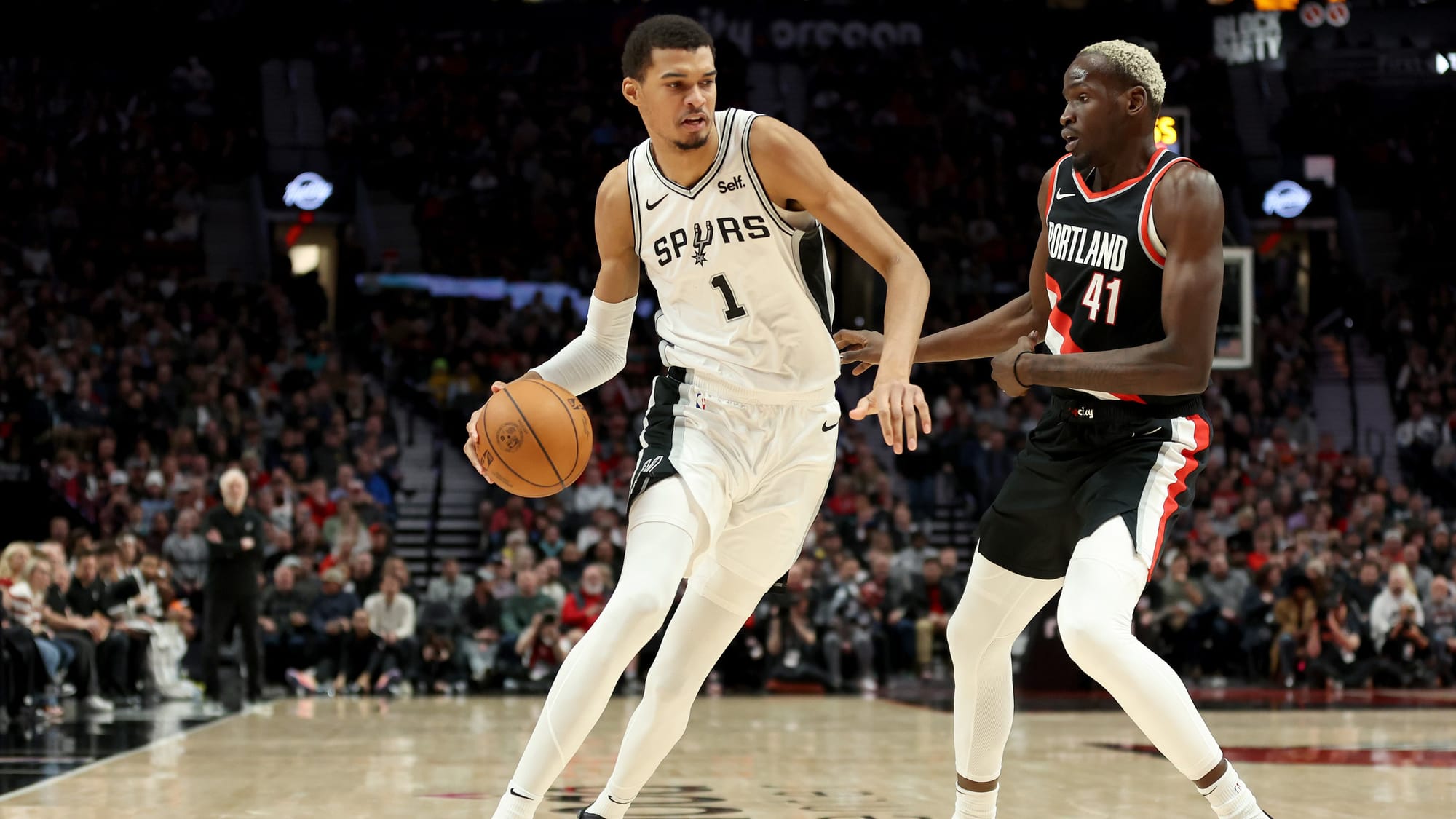
Speaking of which, it was great, and long overdue, for the Blazers to finally get their own G League team. Why it took this long is a discussion for another day (you can probably figure out who didn’t think it was worthwhile for a decade), but the first season of the Remix was a complete across-the-board success. On the basketball side, it gave Badji, Rayan Rupert, Kris Murray and Justin Minaya the opportunity to play in real games when they weren’t in the Blazers’ rotation, and all four of them got meaningfully better from the start to the end of the season because of it. On the business side, they crushed the name and logo on an extremely tight turnaround time (I have yet to meet or hear from one person who doesn’t like it), and Hand Fruit Nation is a totally organic fan-driven phenomenon that sprung up from it. I went to well over half of their home games at Chiles Center—as many as I could get to—and really enjoyed covering them. I got to know their head coach, Jim Moran, and GM, Danny Connors, pretty well over the course of the year as well as a lot of the support staff.
By far, the most memorable game of the season was Lillard’s return to Portland with the Bucks on Jan. 31, for all the reasons you’d think. I thought the Blazers’ game-ops department did a great job with the tribute videos—sufficiently meaningful without being over-the-top—and the crowd recaptured the playoff energy that was understandably hard to muster up for most of the season. It was a really good game, too. I don’t feel like re-litigating everything that went on last summer. But I think things ended up working out with the final result of the split. Cronin got a better return on the trade than he would have with the other rumored destination and, as dicey as Milwaukee looks going into the playoffs, it’s a better basketball situation for Lillard than the other one would have been. And I still think, for all the ugliness of the summer, that Lillard and Cronin will ultimately get past the hard feelings, whether that happens now or in a few years. But, as I said above, the first few years after losing a player and person like Lillard were always going to be a pretty tough watch.
If you’re part of the group of fans I heard from that actually wanted to watch these games, chances are you weren’t able to, unless you have cable or fuboTV. Even as someone who pays way too much money for cable to be able to watch these games, I was frustrated with ROOT Sports’ poor picture and sound quality and technical issues, as well as the amount of times the Blazers got bumped to ROOT Plus, which not everybody gets, because the main ROOT channel was rerunning episodes of their Kraken studio show. Between that and Comcast’s 11th-hour announcement before the start of the season that ROOT would only be available on their highest-priced tier of channels—which the Blazers were also blindsided by, for what it’s worth—it’s no wonder their local ratings cratered. With the options that were available to them at the time, I understand why the Blazers signed the deal in 2021, but that doesn’t mean it hasn’t been a disaster. Friend of the program Danny Marang has reported that the Blazers are actively exploring ways to ensure that what happened this year doesn’t happen again going forward. I’m hopeful that by the start of next season, something will change. The team has experimented with putting Remix games and their own preseason games over the air on Fox 12 Plus, and the Utah Jazz have had success rolling out their own paid streaming service for fans in their local market. I don’t know all the logistical details yet, and neither do the Blazers. But long-term, I’m expecting them to move to one of these two models, or maybe even a combination of both.
These are the three best jerseys I saw at Moda Center this season:
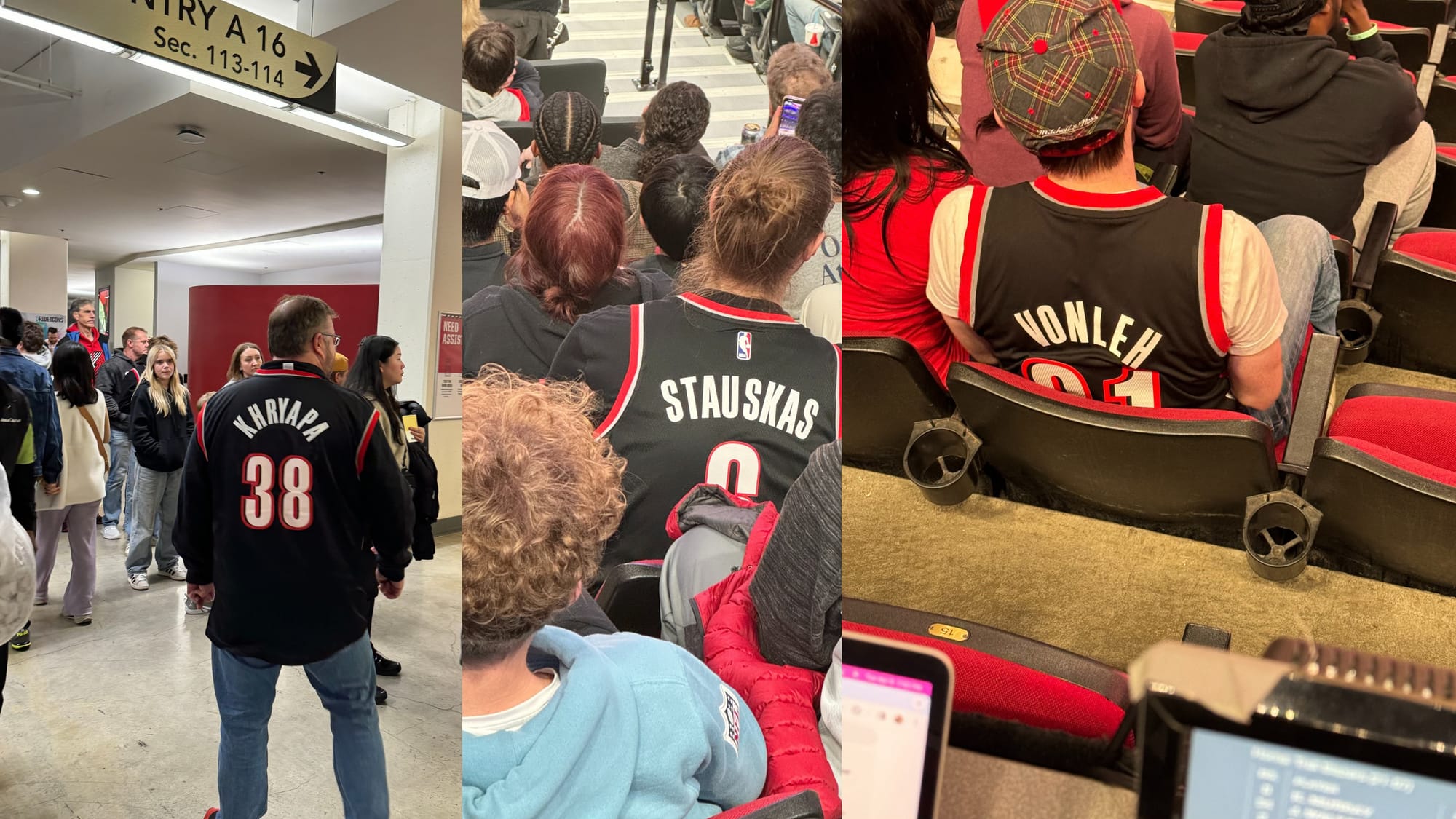
Without getting into exact numbers, this season was a tough one for me in terms of the growth I was hoping for. I added a decent amount of new paid subscribers, but I had almost as many drop off, which I totally get—it’s not as much fun to follow a 61-loss team day-to-day as it is to follow a team in the mix for the playoffs. Between subs added and lost, I’m right around even from where I was at the start of the season to where I am now. In a season like this, I consider that a win. I appreciate every single one of you that’s stuck with me and hasn’t checked out because of how this season has gone. Growing is hard in a season like this, when there isn’t much happening on the court for fans to get excited about but I still feel, and hope, that I gave those of you who are paid subscribers your money’s worth. If you’re one of those people, thank you, and consider spreading the word—more than half the battle in this media economy is people even knowing you exist when you’re not backed by a mainstream outlet with a lot of resources.
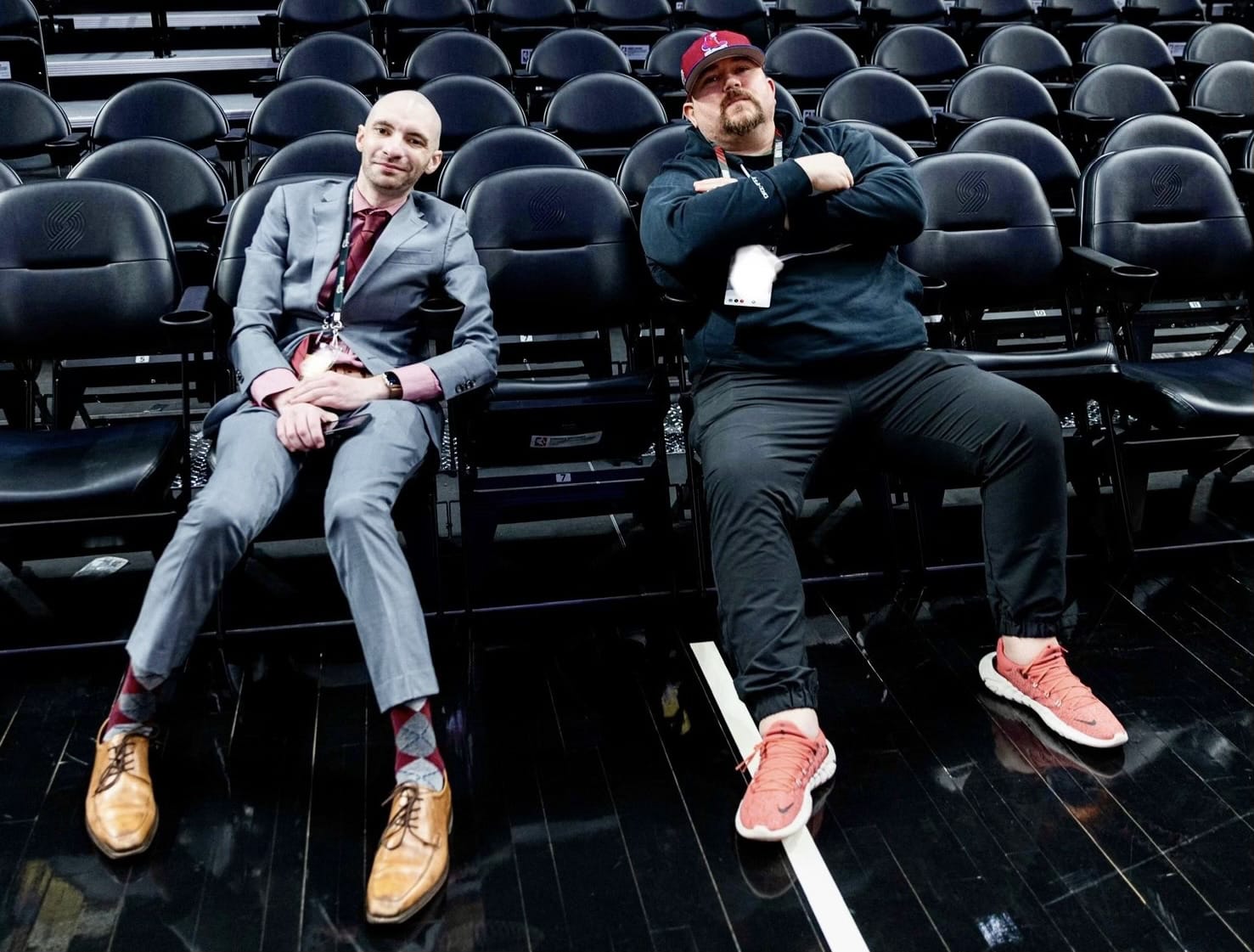
Subs aside, I had a couple of fun professional milestones. I was voted Oregon Sportswriter of the Year for 2023 by the National Sports Media Association in January, and the site was recently accepted into the most reputed professional group in the industry, the Associated Press Sports Editors, as a member organization. As I wrote when the NSMA announcement came down in January, I don’t chase after those sorts of accolades, but that doesn’t mean it isn’t cool when you get them, as well as pretty damn validating of the work I’m doing.
I’m excited to have a real offseason this year. That wasn’t really possible last summer because Lillard requested a trade on July 1 and the Bucks deal didn’t get done until Sept. 27. It was especially annoying because the three central facts of the story—that he wanted to be traded, that he wanted to go specifically to Miami, and that the Blazers weren’t in love with any of the Heat’s potential trade assets—were all known publicly on July 1 and didn’t change at any point between then and the day the trade happened. And the Blazers barely made any other moves during that time, because they needed to wait until the Lillard trade got sorted out to build out the rest of the roster. So not only was it impossible for me to unplug because the trade could happen at any moment, we also went three months without there being any new information or developments. There was nothing new to talk about and everyone just kept re-litigating those same three central facts over and over out of boredom and the need to keep producing content. This year, I’m expecting a return to normalcy. The Blazers should get most of their offseason business done by mid-July. Maybe I’ll even take a vacation that isn’t work-related, something I haven’t done since well before the pandemic.
Tomorrow, the team is holding exit interviews at their practice facility and there will be end-of-season press conferences with Cronin, Billups and most of the players. I’ll be there and we’ll cover what there is to cover from all of it. After that, I’m going to take a little time to reset and clear my head. There are a couple of roster lookahead pieces for the offseason that I’ve already written and will go up next week, and we’ll do another mailbag later in the month. I’m also going to start digging in on a couple of long-term feature projects I’m really excited about, now that I have a little downtime. Things will really ramp back up in mid-May, when I go to Chicago for the lottery and predraft combine. After that, we’ll know where the Blazers are picking and they’ll start bringing players in for workouts, which will lead right into the draft, and then free agency and Summer League. I’ll talk to you all soon.